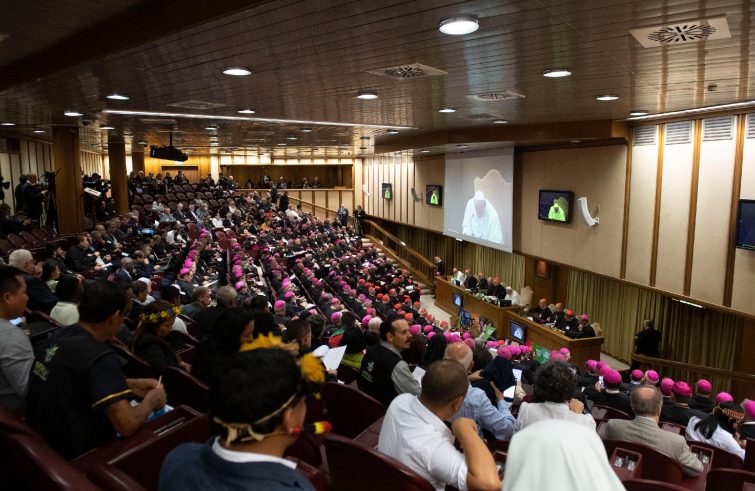
It is “a tool to facilitate the first phase of listening to and consulting the People of God in the particular Churches (October 2021 – April 2022), in the hope of helping to set in motion the ideas, energy, and creativity of all those who will take part in the journey, and to make it easier to share the fruits of their efforts”, reads the preparatory document of the Synod of Bishops titled “For a Synodal Church: communion, participation and mission“, which Pope Francis will open with a solemn celebration on October 10. The process will continues on October 17 at diocesan level worldwide.
The celebration of the XVI Ordinary General Assembly of the Synod of Bishops in October 2023 will mark the fundamental stage, followed by the implementation phase, involving all dioceses. A methodological Handbook, annexed to this Preparatory Document and available on the dedicated hosting website, is proposed. It offers “some resources for deepening the theme of synodality”, including, inter alia, the Address at the Ceremony Commemorating the 50th Anniversary of the Institution of the Synod of Bishops, given by Pope Francis on the 17th of October 2015, and the document Synodality in the Life and Mission of the Church, prepared by the International Theological Commission and published in 2018.
“The Church of God is convoked in Synod”,
read the opening lines of the document, following Pope Francis’ invitation to the entire Church to reflect on a decisive theme for her life and mission: “It is precisely this path of synodality which God expects of the Church of the third millennium.” “A global tragedy such as the COVID-19 pandemic momentarily revived the sense that we are a global community, all in the same boat.” At the same time, “the pandemic has also made the already existing inequalities and inequities explode”, is the analysis contained in the document, which denounces:
“The tragic condition faced by migrants in all regions of the world shows how high and strong the barriers dividing the single human family still are.”
Thw challenge that lies ahead for the Church is “to accompany individuals and communities to reread experiences of mourning and suffering that have unmasked many false certainties, and to cultivate hope and faith in the goodness of the Creator and his creation.”
“However, we cannot hide from the fact that the Church herself must face the lack of faith and the corruption even within herself”,
is the “mea culpa” put forward in the document, recalling “the suffering experienced by minors and vulnerable people due to sexual abuse, the abuse of power and the abuse of conscience perpetrated by a significant number of clerics and consecrated persons.” “We are continually challenged as the People of God to take on the pain of our brothers and sisters wounded in their flesh and in their spirit.” In fact, the document notes, “for too long, the document the cry of the victims has been a cry that the Church has not been able to hear sufficiently. These are deep wounds that are difficult to heal, for which forgiveness can never be asked for enough and which constitute obstacles, sometimes imposing ones, to advancing in the direction of journeying together.” “The whole Church is called to deal with the weight of a culture imbued with clericalism that she inherits from her history, and with those forms of exercising authority on which the different types of abuse (power, economic, conscience, sexual) are grafted.” The appeal: “it is impossible to think of a conversion of our activity as a Church that does not include the active participation of all the members of God’s People: together let us ask the Lord for the grace of conversion and the interior anointing needed to express before these crimes of abuse our compunction and our resolve courageously to combat them.” New paths are flourishing, notably “the desire of young people to be protagonists within the Church and the request for a greater appreciation of women and spaces for participation in the mission of the Church”, such as the recent institution of the lay ministry of Catechist and the opening of access to those of Lector and Acolyte to women also move in this direction.
“We cannot ignore the variety of conditions in which Christian communities live in the different regions of the world”,
is stated in the Text, which denounces the persecution of Christians in countries where they are a minority group. “If, on the one hand, a secularized mentality tends to expel religion from the public space, on the other hand, religious fundamentalism, without respect for the liberties of others, feeds forms of intolerance and violence that are also reflected in the Christian community and in its relations with society”, the cry of alarm:
“Christians not infrequently adopt the same attitudes, even fomenting divisions and opposition, including within the Church.”
Within the Church and in its relations with society, reverberate “the fractures caused by reasons of ethnicity, race, caste, or other forms of social stratification or cultural and structural violence, which run through the latter.” In this perspective, synodality “is much more than the celebration of ecclesial meetings and Bishops’ assemblies, or a matter of simple internal administration within the Church; it is the specific modus vivendi et operandi of the Church.”
“Consultation of the People of God does not imply the assumption within the Church of the dynamics of democracy based on the principle of majority”,
the document points out. The main objectives of the Synodal journey include “examining how responsibility and power are lived in the Church as well as the structures by which they are managed, bringing to light and trying to convert prejudices and distorted practices that are not rooted in the Gospel.”










